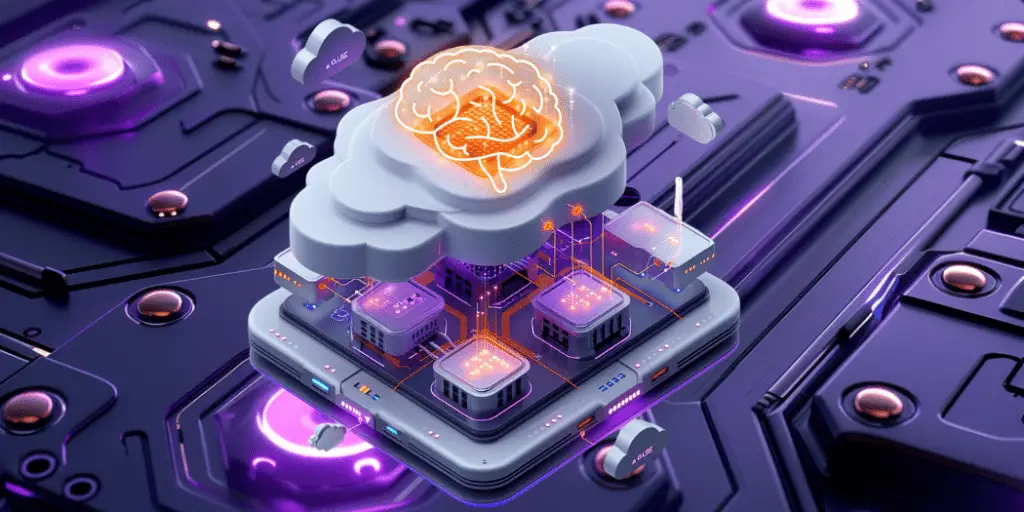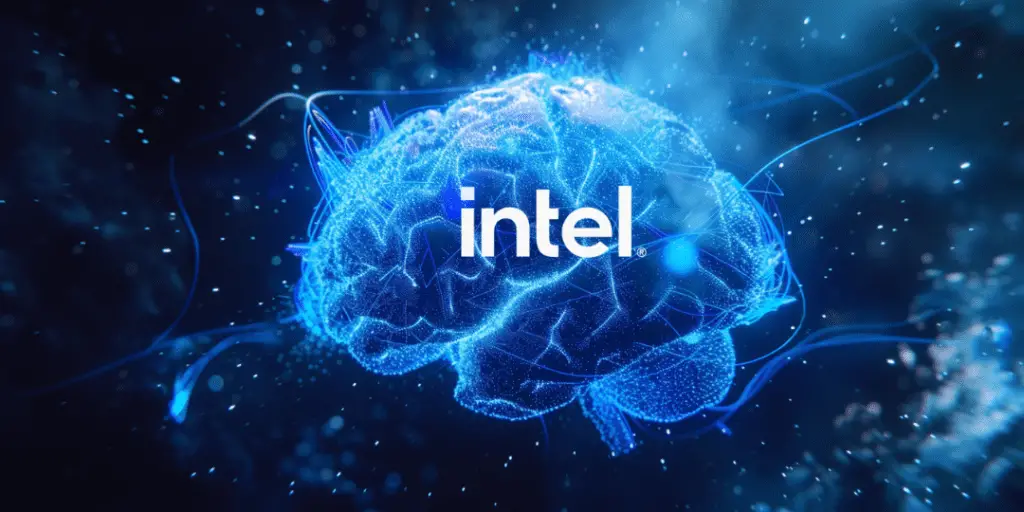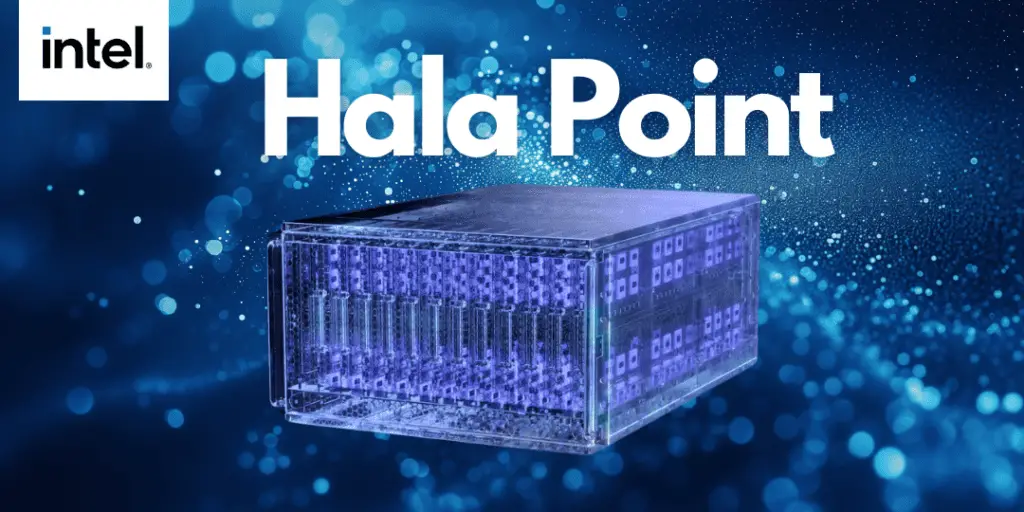Intel’s Hala Point Neuromorphic System the world’s most extensive neuromorphic computing system, marking a significant leap forward in the quest for more sustainable and efficient artificial intelligence.
This cutting-edge system, named after its unique capabilities and vast scale, integrates 1.15 billion neurons and 128 billion synapses, heralding a new era of AI technology that mimics the human brain’s functionality.
Deployed initially at Sandia National Laboratories, Hala Point showcases remarkable improvements in computational efficiency and promises to transform a variety of fields through its advanced brain-inspired computing mechanisms.
This introduction of neuromorphic technology paves the way for AI systems that can learn and function in radically new and improved ways, tackling some of the most pressing challenges traditional AI architectures face today.
Intel’s Hala Point Neuromorphic System
Intel recently launched Hala Point, the world’s most extensive neuromorphic computing system, a monumental achievement in artificial intelligence.
This state-of-the-art system is designed to emulate the human brain’s neural structures and functions, offering an unprecedented scale with 1.15 billion neurons and 128 billion synapses.
Built on Intel’s advanced Loihi 2 processor technology, Hala Point enhances architectural efficiency and processing capacity, significantly surpassing its predecessor, Pohoiki Springs.
Hala Point is not just a marvel in terms of its neuron capacity; it’s also a powerhouse in performance.
Featuring 1,152 Loihi 2 processors and over 2,300 embedded x86 processors, this system is housed in a compact six-rack-unit data centre chassis approximately the size of a microwave oven.
Despite its compact size, it doesn’t skimp on power, with the ability to support massive computational tasks consuming a maximum of 2,600 watts of power.
This system’s robust capabilities enable it to perform up to 20 quadrillion operations per second with an efficiency that exceeds 15 trillion 8-bit operations per second per watt.
Such metrics demonstrate Hala Point’s capability to efficiently handle mainstream AI workloads. They underscore its potential to lead to more sustainable AI practices by reducing the energy consumption typically associated with large-scale AI computations.
Hala Point is currently deployed at Sandia National Laboratories and is used for advanced brain-scale computing research.

This research focuses on several critical areas, including scientific computing problems in device physics, computer architecture, and informatics.
The goal is to leverage Hala Point’s unique capabilities to push forward the boundaries of what’s possible in AI, transforming approaches to problem-solving across various domains such as logistics, smart city infrastructure management, and large language models.
Intel’s commitment to advancing neuromorphic computing is evident in Hala Point’s development and deployment.
As this technology progresses, it promises to enhance the capabilities of AI systems and revolutionize the way we approach computing, learning, and problem-solving in the digital age.
Technical Innovations
Intel’s Hala Point represents a significant technological leap in neuromorphic computing, showcasing a series of innovations and advancements that set it apart from previous systems.
Central to these improvements is the integration of Intel’s second-generation Loihi 2 processor, which brings numerous enhancements in architecture, performance, and efficiency.
With substantial architectural upgrades, Hala Point advances upon its predecessor, Pohoiki Springs. These include increased neuron capacity—over 10 times that of the earlier model—and up to 12 times higher performance.
The system’s design integrates 1,152 Loihi 2 processors, showcasing an advanced use of Intel’s 4 process node technology within a compact six-rack unit.
This configuration optimizes space without sacrificing power, accommodating 1.15 billion neurons and 128 billion synapses across 140,544 neuromorphic processing cores.
Regarding performance, Hala Point sets a new standard for computational efficiency in AI workloads.
It can execute up to 20 quadrillion operations per second with an efficiency exceeding 15 trillion 8-bit operations per second per watt.
This efficiency metric is particularly notable compared to traditional computing architectures like GPUs and CPUs, as it demonstrates Hala Point’s superior capability in executing conventional deep neural networks with far greater energy efficiency.
One of the most significant advancements in Hala Point is its energy efficiency. Given its computational power, the system consumes a meager 2,600 watts of power.
This is achieved through the neuromorphic design, which mimics biological processes. This allows for asynchronous, event-based data processing that drastically reduces power consumption compared to synchronous computing methods.
Hala Point utilizes spiking neural networks closer to biological neural networks than traditional artificial neural networks.
SNNs in Hala Point communicate through spikes—a digital signal miming how neurons in the human brain communicate.
This method of data processing reduces latency and power consumption and allows the system to handle real-time data streams more effectively, enhancing its capabilities in dynamic environments.
These technical innovations position Hala Point not just as a benchmark for neuromorphic computing but also as a pioneering solution that could lead to broader applications of AI in real-world settings, where power efficiency and fast data processing are critical.
Through these advancements, Intel not only pushes the boundaries of what neuromorphic technology can achieve but also sets the stage for future developments that could transform entire industries.
Applications and Expected Impact
Intel’s Hala Point, the world’s most extensive neuromorphic system, heralds a new era in computing with its brain-inspired capabilities. This revolutionary technology can significantly impact various sectors by enabling more efficient, real-time processing of complex datasets.
Hala Point’s advanced computing capabilities make it an invaluable scientific research and engineering tool. Its ability to simulate neural processes offers researchers new ways to model complex physical phenomena.
For instance, its deployment at Sandia National Laboratories involves using the system for device physics, computer architecture, and informatics, potentially accelerating breakthroughs in these fields.
In logistics, Hala Point can optimize routing and supply chain operations by processing real-time data streams more efficiently than conventional systems.
Its potential for managing intelligent city infrastructures is also significant; it could dynamically control traffic flow, public transportation, and energy distribution systems, leading to more sustainable urban development.
Hala Point’s capabilities extend to enhancing large language models and AI agents.

Hala Point can significantly reduce the computational and energy costs associated with maintaining state-of-the-art AI systems by enabling these models to learn continuously from new data without periodic retraining.
This makes AI more sustainable and accessible, from customer service bots to more sophisticated AI-driven analytics.
One of Hala Point’s most promising applications is continuous learning. Unlike traditional AI models that require extensive retraining on large datasets, Hala Point’s neuromorphic architecture allows it to quickly adapt to new information.
This capability is crucial for applications where conditions change rapidly, such as autonomous driving and real-time financial trading.
The deployment of Hala Point is expected to address some of the most pressing sustainability issues facing the AI industry today.
Its high efficiency and low power consumption can significantly reduce the environmental impact of large-scale AI computations, traditionally known for their high energy demands.
By reducing the energy footprint of AI operations, Hala Point sets a new standard for future developments in the field, emphasizing the importance of sustainable practices in technological advancement.
Hala Point’s innovative applications across diverse domains showcase its versatility and its potential to redefine what is possible in AI, making a profound impact on how industries operate and how AI is integrated into our daily lives.
This aligns with a broader shift towards more responsible and efficient computing solutions, paving the way for a future where AI and sustainability coexist.
Research Collaborations
Intel’s Hala Point, with its groundbreaking neuromorphic capabilities, is a technological achievement and a cornerstone for collaborative research in advanced computing.
This initiative’s pivotal elements are its deployment at Sandia National Laboratories and its engagement with the broader scientific community.
Hala Point’s first deployment site is Sandia National Laboratories, a national security and technology innovation leader. Sandia’s focus on cutting-edge computer science, device physics, and informatics research makes it an ideal setting for exploiting Hala Point’s capabilities.
The lab utilizes the system for advanced brain-scale computing projects, aiming to solve complex scientific and computational challenges.
This collaboration allows researchers to push the boundaries of what’s possible in scientific computing, leveraging Hala Point’s unique ability to mimic the human brain’s processing capabilities.
At Sandia, Hala Point is instrumental in enhancing the lab’s computational modelling capabilities. It facilitates more accurate and efficient simulations of complex systems, which is crucial for advancing research in fields ranging from defence to environmental science.
By enabling faster and more energy-efficient computations, Hala Point helps Sandia maintain its leadership in solving national security challenges and other critical scientific issues.
Intel has fostered a vast network of collaborations through the Intel Neuromorphic Research Community, which includes over 200 members.
This community spans leading academic groups, government labs, and research institutions worldwide. INRC members collaborate on various projects to explore and expand neuromorphic computing applications.
Through these partnerships, Intel and its collaborators aim to refine the technology further and discover new use cases that can benefit from Hala Point’s advanced capabilities.
The collaborative nature of the research involving Hala Point is critical to its success and future development.
These partnerships enhance the system’s practical applications and contribute to the collective knowledge base in neuromorphic computing.
By working together, Intel and its partners can tackle some of the most challenging problems in AI and computing, making strides towards systems that are not only powerful but also sustainable and efficient.
Intel plans to continue expanding the deployment of neuromorphic systems like Hala Point to other research facilities and potentially into commercial settings.
This expansion will likely focus on overcoming power and latency constraints that limit current AI capabilities, enabling real-world, real-time applications across various sectors.
Through these strategic deployments and collaborations, Intel is setting the stage for a new era of computing where neuromorphic technology plays a central role in advancing both the capabilities and the sustainability of artificial intelligence systems.
Future Prospects and Goals
Intel’s creation of Hala Point marks a pivotal advance in neuromorphic computing, with broad implications for the future of artificial intelligence.
The success of this initiative sets a clear path for subsequent developments, focusing on enhancing the capabilities, scalability, and commercial viability of neuromorphic systems.
One of the primary goals for the future is to scale neuromorphic technology to more comprehensive applications and greater adoption.
Intel plans to extend the reach of systems like Hala Point to more research institutions and eventually into industry-specific applications.
This will involve refining the technology and proving its utility in real-world scenarios that can benefit from neuromorphic computing’s unique strengths, such as energy efficiency and real-time processing.
A key driver behind the development of Hala Point is the need to address the sustainability challenges posed by traditional AI systems.
As AI models become increasingly large and complex, their energy consumption has soared, raising concerns about the environmental impact of AI at scale.

Hala Point’s efficient design—capable of executing operations with significantly reduced power—is a model for future developments to make AI more sustainable.
Intel aims to leverage the lessons learned from Hala Point to reduce the overall power consumption and global carbon footprint of AI systems.
While currently a research prototype, Hala Point’s future includes plans to transition the technology into commercial products.
Intel anticipates that the advancements made with Hala Point will lead to practical applications in industries such as telecommunications, automotive, healthcare, and more.
This transition will likely focus on integrating neuromorphic computing elements into existing digital infrastructures to enhance performance and efficiency.
Another exciting prospect for neuromorphic computing is the potential for AI systems to engage in continuous learning, adjusting to new data in real-time without retraining.
This capability could revolutionize fields that depend on dynamic data inputs, such as predictive analytics and autonomous systems.
Intel aims to further develop this aspect of neuromorphic technology, making AI models more efficient and more adaptable and intelligent over time.
Intel continues to expand its Intel Neuromorphic Research Community (INRC), fostering collaborations that push the boundaries of what neuromorphic computing can achieve.
These partnerships are crucial for pooling expertise, sharing resources, and tackling complex challenges that no single entity can address.
Intel’s commitment to collaborative growth reflects its strategy to catalyze global advancements in AI technology, making neuromorphic systems a cornerstone of future innovations.
Final Thoughts
The unveiling of Intel’s Hala Point marks a significant milestone in the evolution of computing technology. It showcases the immense potential of neuromorphic systems to transform the landscape of artificial intelligence.
With its unparalleled scale and efficiency, Hala Point addresses the immediate challenges of power consumption and computational efficiency in AI. It sets a new standard for future developments in the field.
Hala Point’s deployment at Sandia National Laboratories and integration within the broader Intel Neuromorphic Research Community signify a robust collaborative effort to refine and expand neuromorphic computing capabilities.
The system’s ability to emulate the human brain’s mechanisms opens up many possibilities for advanced problem-solving in scientific research, logistics, innovative city management, and beyond, making it a pivotal tool in pushing the boundaries of what AI can achieve.
Intel’s commitment to advancing this technology from a research prototype to a mainstay in commercial applications illustrates a clear vision for the future—one where AI is more efficient and sustainable, adaptable and capable of continuous learning.
This progress is crucial for meeting the growing demands of various industries and for fostering an environment where technology and sustainability coexist harmoniously.
As we move forward, the lessons learned and the advancements made with Hala Point will undoubtedly influence the broader AI community, driving further innovations and inspiring new approaches to tackle the ever-evolving challenges of our digital age.
Intel’s Hala Point is more than just a technological achievement; it is a beacon for the future of artificial intelligence, heralding a new era of more intelligent, more sustainable computing.


